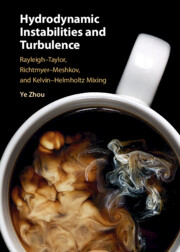 Hydrodynamic Instabilities and Turbulence
Hydrodynamic Instabilities and Turbulence Book contents
- Frontmatter
- Dedication
- Contents
- Preface
- Acknowledgments
- Part 1 Fundamentals
- Part 2 Hydrodynamics of Complex Flows
- 9 Influence of initial conditions
- 10 Flow properties
- 11 Rotation and time-dependent acceleration
- 12 Direction, strength, and shape of incident shock waves
- 13 Reshock andmulti-shocks
- 14 Combined instabilities
- 15 Geometrical configurations
- 16 Convergent/divergent geometry
- 17 Magnetohydrodynamic fluid instabilities
- Part 3 From the Microscopic to Cosmic Scales
- References
- Index
14 - Combined instabilities
from Part 2 - Hydrodynamics of Complex Flows
- Frontmatter
- Dedication
- Contents
- Preface
- Acknowledgments
- Part 1 Fundamentals
- Part 2 Hydrodynamics of Complex Flows
- 9 Influence of initial conditions
- 10 Flow properties
- 11 Rotation and time-dependent acceleration
- 12 Direction, strength, and shape of incident shock waves
- 13 Reshock andmulti-shocks
- 14 Combined instabilities
- 15 Geometrical configurations
- 16 Convergent/divergent geometry
- 17 Magnetohydrodynamic fluid instabilities
- Part 3 From the Microscopic to Cosmic Scales
- References
- Index
Summary
The challenge confronting researchers is significant in many ways. One can start by noting that multiple instabilities might exist simultaneously and interact with each other. As an example, oblique shocks generate all three instabilities: RT, RM, and KH. In this chapter, several combined instabilities are discussed: RTI and RMI, RTI and/or RMI with KHI.
- Type
- Chapter
- Information
- Hydrodynamic Instabilities and TurbulenceRayleigh–Taylor, Richtmyer–Meshkov, and Kelvin–Helmholtz Mixing, pp. 277 - 285Publisher: Cambridge University PressPrint publication year: 2024
